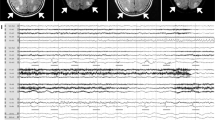Abstract
To better describe seizure type, frequency, and electroencephalographic (EEG) findings in posterior reversible encephalopathy syndrome (PRES) and correlate these data with clinical and magnetic resonance imaging (MRI) data, we retrospectively assessed medical charts and EEG studies of patients with PRES treated between 2004 and 2011. Data collected included patients’ underlying pathology, lesion distribution by MRI, seizure type and frequency, EEG pathologic background activity, focal pathology, and epileptogenic activity. Thirty-eight of 49 adults with PRES suffered from seizures; 17 underwent EEG and were included in the analysis. Perpetuating factors were similar to those reported in the literature. In 15 of 17 patients, MRI showed widespread involvement rather than purely occipital lesions. Nine patients had subcortical and cortical involvement. Seizures were single short grand mal (GM) in 11, serial GM in 2, recurrent GM in 2, and additional focal seizures in 2. No seizures were noted beyond the first day. After discontinuation of antiepileptic medication, no patients experienced seizure recurrence during 6-month follow-up. EEG showed diffuse theta/delta slowing in 13 patients and epileptogenic activity with focal sharp-wave and periodic lateralizing epileptiform discharges in 2 patients. Seizures in PRES are most commonly single GM and are usually of limited duration. EEG shows variable theta/delta slowing. Focal EEG pathology is seen in patients with focal seizures. Seizures occur early after disease onset and terminate spontaneously or under therapy during the first 24 h. Seizure recurrence beyond 24 h and chronic epilepsy were not seen. Seizures in PRES are frequent but appear to be uncomplicated and do not herald worse prognosis. EEG is helpful in evaluating the degree of encephalopathy and monitoring epileptic activity. Long-term antiepileptic medication does not appear to be warranted.


Similar content being viewed by others
References
Casey SO, Sampaio RC, Michel E, Truwit CL (2000) Posterior reversible encephalopathy syndrome: utility of fluid-attenuated inversion recovery MR imaging in the detection of cortical and subcortical lesions. Am J Neuroradiol 21:1199–1206
Dillon WP, Rowley H (1998) The reversible posterior cerebral edema syndrome. Am J Neuroradiol 19:591–595
Trullemans F, Grignard F, van Camp B, Schots R (2001) Clinical findings and magnetic resonance imaging in severe cyclosporine-related neurotoxicity after allogeneic bone marrow transplantation. Eur J Haematol 67:94–99
Kastrup O, Diener HC (1997) Granulocyte-stimulating factor filgrastim and molgramostim induced recurring encephalopathy and focal status epilepticus. J Neurol 244:274–275
Kastrup O, Maschke M, Wanke I, Diener HC (2002) Posterior reversible encephalopathy syndrome due to severe hypercalcemia. J Neurol 249:1563–1566
Hinchey J, Chaves C, Appignani B et al (1996) A reversible posterior leukoencephalopathy syndrome. N Engl J Med 334:494–500
Obeid T, Shami A, Karsou S (2004) The role of seizures in reversible posterior leukoencephalopathy. Seizure 13:277–281
Roos KL, Tuite PJ, Below ME, Pascuzzi RM (1990) Reversible cortical blindness (Anton’s syndrome) associated with bilateral occipital EEG abnormalities. Clin Electroencephalogr 21:104–109
Grimbert P, Azema C, Pastural M et al (1999) Tacrolismus (FK506)-induced severe and late encephalopathy in a renal transplant recipient. Nephrol Dial Transplant 14:2489–2491
Parvex P, Piinsk M, Bell LE et al (2001) Reversible encephalopathy associated with tacrolimus in pediatric renal transplants. Pediatr Nephrol 16:537–542
Bhatt A, Faroog MU, Bhatt S, Majid A, Kassab MY (2008) Periodic lateralized epileptiform discharges: an initial electrographic pattern in reversible posterior leukoencephalopathy syndrome. Neurol Neurochir Pol 42:55–59
Kozak OS, Wijdicks EF, Manno EM, Miley J, Rabinstein AA (2007) Status epilepticus as initial manifestation of posterior reversible encephalopathy syndrome. Neurology 69:894–897
Baldini M, Bartolini E, Gori S, Bonanni E, Cosottini M, Ludice A, Murri L (2010) Epilepsy after neuroimaging normalization in a woman with tacrolismus-related posterior reversible encephalopathy syndrome. Epilepsy Behav 17:558–560
Skiba V, Etienne M, Miller JA (2011) Development of chronic epilepsy after recurrent episodes of posterior reversible encephalopathy syndrome associated with periodic lateralized epileptiform discharges. Seizure 20:93–95
Natsume J, Sofue A, Yamada A, Kato K (2006) Electroencephalographic (EEG) findings in posterior reversible encephalopathy associated with immunosuppressants. J Child Neurol 21:620
Servillo G, Bifulco F, De Robertis E et al (2007) Posterior reversible encephalopathy syndrome in intensive care medicine. Intensive Care Med 33:230–236
Conflicts of interest
None.
Author information
Authors and Affiliations
Corresponding author
Rights and permissions
About this article
Cite this article
Kastrup, O., Gerwig, M., Frings, M. et al. Posterior reversible encephalopathy syndrome (PRES): electroencephalographic findings and seizure patterns. J Neurol 259, 1383–1389 (2012). https://doi.org/10.1007/s00415-011-6362-9
Received:
Revised:
Accepted:
Published:
Issue Date:
DOI: https://doi.org/10.1007/s00415-011-6362-9




